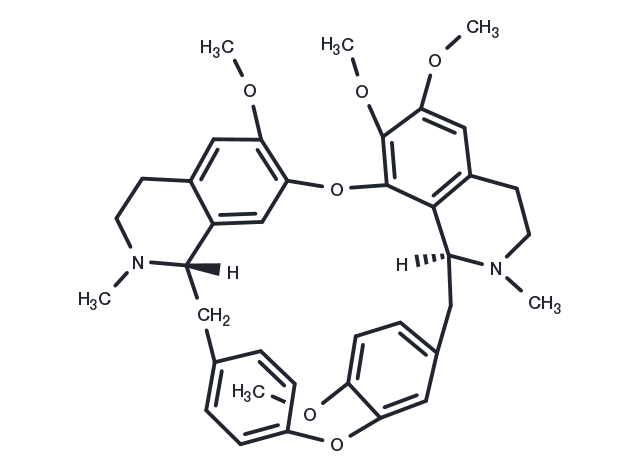Powder: -20°C for 3 years | In solvent: -80°C for 1 year


Tetrandrine (Sinomenine A) is a natural, bis-benzylisoquinoline alkaloid isolated from the root of the plant. Tetrandrine non-selectively inhibits calcium channel activity and induces G1 blockade of the G1 phase of the cell cycle and apoptosis in various cell types, resulting in immunosuppressive, anti-proliferative and free radical scavenging effects.

| Pack Size | Availability | Price/USD | Quantity |
|---|---|---|---|
| 100 mg | In stock | $ 43.00 | |
| 500 mg | In stock | $ 89.00 | |
| 1 mL * 10 mM (in DMSO) | In stock | $ 45.00 |




| Description | Tetrandrine (Sinomenine A) is a natural, bis-benzylisoquinoline alkaloid isolated from the root of the plant. Tetrandrine non-selectively inhibits calcium channel activity and induces G1 blockade of the G1 phase of the cell cycle and apoptosis in various cell types, resulting in immunosuppressive, anti-proliferative and free radical scavenging effects. |
| In vitro | In mice, the LD50 of Tetrandrine administrated via intravenous injection is 158.9 mg/kg, and when administered via intraperitoneal injection, the LD50 is 365 mg/kg. In rats, the LD50 of Tetrandrine administered via oral gavage is 646 mg/kg. |
| In vivo | In isolated rat pituitary nerve terminals, Tetrandrine inhibits voltage-gated Ca2+ currents (IC50=10.1 mM) and acts as a high-affinity blocker of the type II maxi-Ca(2+)-activated K+ channels (IC50=0.21 mM) present in these terminals. Moreover, Tetrandrine can suppress Ca(2+)-activated Cl- currents (IC50=5.2 mM). Additionally, in human leukemia HL-60 cells, Tetrandrine is capable of inhibiting cell proliferation and inducing apoptosis. |
| Source |
| Synonyms | NSC-77037, d-Tetrandrine, Hanfangchin A, Fanchinine, Sinomenine A |
| Molecular Weight | 622.75 |
| Formula | C38H42N2O6 |
| CAS No. | 518-34-3 |
Powder: -20°C for 3 years | In solvent: -80°C for 1 year
DMSO: 11.2 mM
You can also refer to dose conversion for different animals. More
bottom
Please see Inhibitor Handling Instructions for more frequently ask questions. Topics include: how to prepare stock solutions, how to store products, and cautions on cell-based assays & animal experiments, etc.
Tetrandrine 518-34-3 Membrane transporter/Ion channel Metabolism Calcium Channel Potassium Channel Ca channels NSC-77037 KcsA NSC 77037 d-Tetrandrine Hanfangchin A NSC77037 Ca2+ channels inhibit Inhibitor Fanchinine Sinomenine A inhibitor
